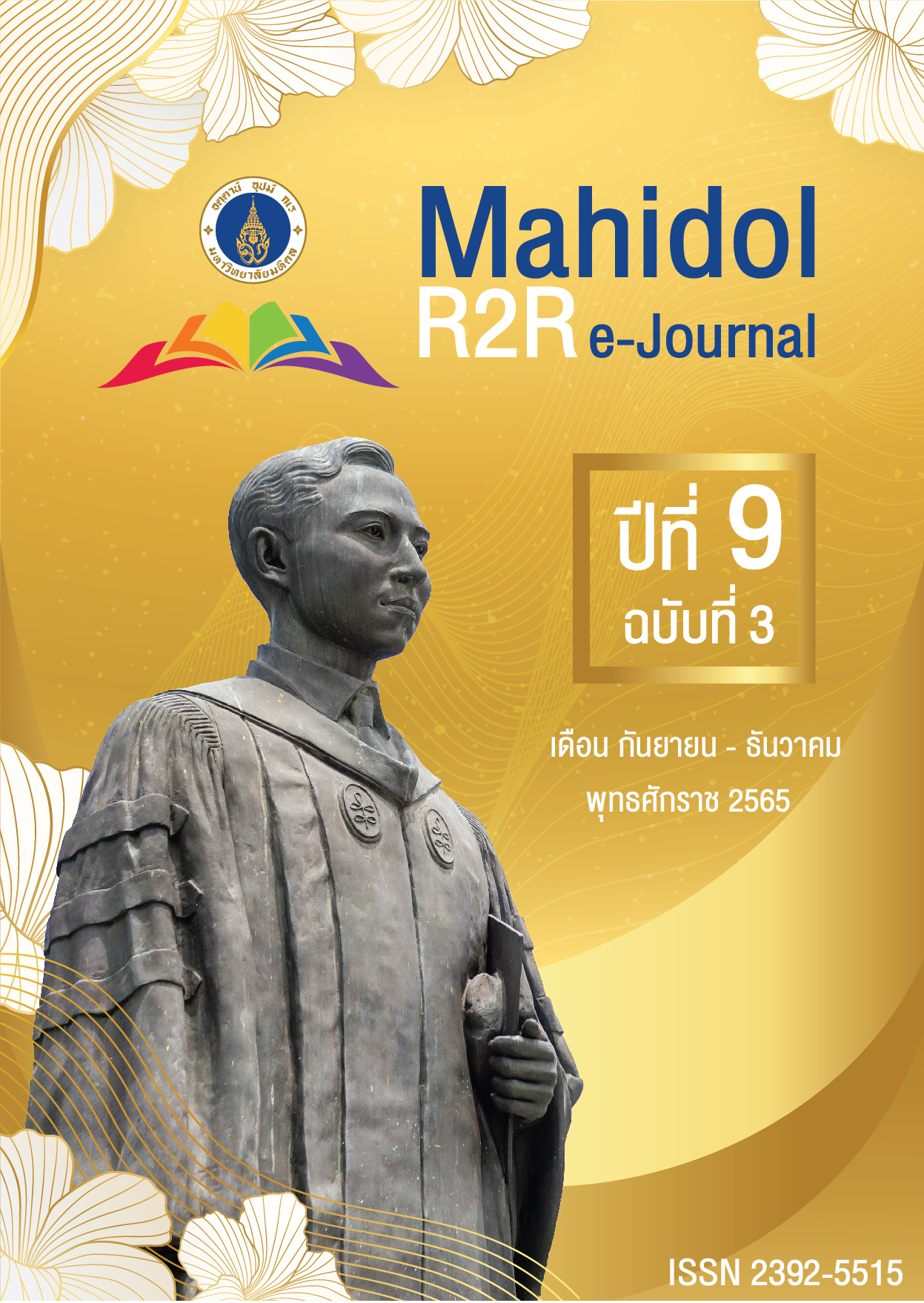โมเดลความสัมพันธ์เชิงสาเหตุระหว่างการรับรู้โครงสร้างมหาวิทยาลัยและความผูกพันต่อองค์กร ที่ส่งผลต่อความพึงพอใจในการทำงานของบุคลากรสายสนับสนุนวิชาการ มหาวิทยาลัยเทคโนโลยีราชมงคลกรุงเทพ
DOI:
https://doi.org/10.14456/jmu.2022.28คำสำคัญ:
การรับรู้โครงสร้างมหาวิทยาลัย, ความผูกพันต่อองค์กร, ความพึงพอใจในการทำงานบทคัดย่อ
การวิจัยนี้มีวัตถุประสงค์ 1) เพื่อพัฒนาโมเดลความสัมพันธ์เชิงสาเหตุระหว่างการรับรู้โครงสร้างมหาวิทยาลัยและความผูกพันต่อองค์กรที่ส่งผลต่อความพึงพอใจในการทำงานของบุคลากรสายสนับสนุนวิชาการมหาวิทยาลัยเทคโนโลยีราชมงคลกรุงเทพ และ 2) เพื่อตรวจสอบความสอดคล้องของโมเดลที่พัฒนาขึ้นกับข้อมูลเชิงประจักษ์ กลุ่มตัวอย่าง คือ บุคลากรสายสนับสนุนวิชาการ จำนวน 260 คน โดยใช้วิธีการสุ่มตัวอย่างแบบตามสะดวก ดำเนินการเก็บข้อมูลโดยใช้ แบบสอบถามออนไลน์ด้วย Google Form และวิเคราะห์โมเดลความสัมพันธ์เชิงสาเหตุโดยใช้โปรแกรม LISREL
ผลการวิจัยพบว่า 1) โมเดลความสัมพันธ์เชิงสาเหตุระหว่างการรับรู้โครงสร้างมหาวิทยาลัยและความผูกพันต่อองค์กรที่ส่งผลต่อความพึงพอใจในการทำงานของบุคลากรสายสนับสนุนวิชาการมหาวิทยาลัยเทคโนโลยีราชมงคลกรุงเทพตามสมมติฐานนั้น มีความสอดคล้องกับข้อมูลเชิงประจักษ์ พิจารณาจากค่าสถิติไค-สแควร์ เท่ากับ 28.17 ค่า df เท่ากับ 23 ค่า p-value เท่ากับ 0.20 ดัชนี GFI เท่ากับ 0.99 ดัชนี AGFI เท่ากับ 0.99 ค่า SRMR เท่ากับ 0.00 ค่า RMSEA เท่ากับ 0.01 และ 2) ความผูกพันต่อองค์กรมีอิทธิพลทางตรงเชิงบวกต่อความพึงพอใจในการทำงานของบุคลากรสายสนับสนุนวิชาการมหาวิทยาลัยเทคโนโลยีราชมงคลกรุงเทพ และการรับรู้โครงสร้างมหาวิทยาลัยมีอิทธิพลทางตรง และทางอ้อมต่อความพึงพอใจในการทำงานของบุคลากรสายสนับสนุนวิชาการมหาวิทยาลัยเทคโนโลยีราชมงคลกรุงเทพ โดยมีตัวแปรความผูกพันธ์ต่อองค์กรเป็นตัวแปรส่งผ่าน ทั้งหมดในโมเดลสามารถอธิบายความแปรปรวนที่ส่งผลต่อความพึงพอใจในการทำงานของของบุคลากรสายสนับสนุนวิชาการ ได้ร้อยละ 80
เอกสารอ้างอิง
ชไมพร กาญจนกิจสกุล. (2555). ระเบียบวิธีวิจัยทางสังคมศาสตร์.โพรเจ๊คท์ ไฟฟ์-โฟว์.
เทียนศร บางม่วงงาม. (2562). ปัจจัยที่มีความสัมพันธ์ต่อความผูกพันต่อองค์การของบุคลากรที่ ผ่านโครงการอบรมวิศวกรใหม่ กรณีศึกษา: บริษัทเอกชนแห่งหนึ่งในเขตกรุงเทพมหานคร. (ศิลปศาสตรมหาบัณฑิต), มหาวิทยาลัยเกริก.
บุญชม ศรีสะอาด. (2556). วิธีการทางสถิติสำหรับการวิจัย เล่ม 1.(พิมพ์ครั้งที่ 5). สุวีริยาสาส์น.
ปณิตา นิรมล และ นันธิดา อนันตชัย. (2563). ความสัมพันธ์ระหว่าง ความพึงพอใจในการปฏิบัติงานและ ความผูกพันต่อองค์กรของบุคลากรมหาวิทยาลัยเทคโนโลยีมหานคร. วารสารบริหารธุรกิจ เทคโนโลยีมหานคร, 17(1), 27-54.
พูลพงศ์ สุขสว่าง. (2560). โมเดลสมการโครงสร้าง. วัฒนาพานิช.
ศักดิ์ชัย จันทะแสง (2564). โมเดลความสัมพันธ์เชิงสาเหตุของความพึงพอใจในการทำงานและความผูกพันต่อองค์กรที่ส่งผลต่อผลการปฏิบัติงานของบุคลากรสายสนับสนุนวิชาการมหาวิทยาลัยเทคโนโลยีราชมงคลกรุงเทพ. วารสารสังคมศาสตร์วิจัย, 12 (1), 95-109.
ศรัณย์ พิมพ์ทอง. (2556). ปัจจัยที่มีอิทธิพลต่อการคงอยู่ในองค์การของพนักงานมหาวิทยาลัยสายวิชาการในประเทศไทย. วารสารบริหารธุรกิจ คณะพาณิชยศาสตร์และการบัญชี มหาวิทยาลัยธรรมศาสตร์, 37(142), 16-32.
สุดารัตน์ พิมลรัตนกานต์ และ วิโรจน์ เจษฎาลักษณ์. (2560). อิทธิพลของการรับรู้บรรยากาศองค์การ ผ่านความพึงพอใจในงานและความผูกพันต่อองค์การที่มีผลการปฏิบัติงานตามบทบาทหน้าที่. Veridian E-Journal, Silpakorn University, 10(2), 1611-1629.
Allen, N. & Meyer, J. (1990). The measurement and antecedents of affective, continuance, and normative commitment to the organization. The Journal of Occupational Psychology, 63 (1), 1-18.
Amin, M. S. (2022). Organizational commitment, competence on job satisfaction and lecturer performance: Social learning theory approach. Golden Ratio of Human Resource Management, 2(1), 40-56.
Armstrong-Stassen, M., & Ursel, N. D. (2009). Perceived organizational support, career satisfaction, and the retention of older workers. Journal of Occupational and Organizational Psychology, 82(1), 201-220. https://doi.org/10.1348/096317908X288838
Bhasin, J., Mushtaq , S., & Gupta , S. (2019 ). Engaging Employees Through Employer Brand : An Empirical Evidence. Management and Labour Studies, 44(4), 417-432.
Butler, R. (2007). Teachers’ achievement goal orientations and associations with teachers’ help seeking: Examination of a novel approach to teacher motivation. Journal of Educational Psychology 99(2), 241–252.
Chawla, P. (2019). Impact of employer branding on employee engagement in business process outsourcing (BPO) sector in India : mediating effect of personorganization fit. Industrial And Commercial training.
Chegini, Z., Janati, A., Asghari-Jafarabadi, M., & Khosravizadeh, O. (2019). Organizational commitment, job satisfaction, organizational justice and self-efficacy among nurses. Nursing Practice Today, 6(2), 86-93.
Christian,M.S., Garza,A.S., & Slaughter, J.E. (2011). Work engagement: A quantitative review and test of its relations with task and contextual performance. Personnel Psychology, 64(1), 89-136.
Davies, G., & Mete , M. (2018). When employer brand image aids employee satisfaction 75 and engagement. Journal of Organizational, 5(1), 64-80.
Edmonds, W. A. & Kennedy, T. D. (2017). An applied guide to research designs: Quantitative, qualitative, and mixed methods. Sage.
Gangai, N. K., & Agrawal, R. (2015). Job satisfaction and organizational commitment: Is it important for exployee performance. Int. J. Manag. Bus. Res, 5(4), 269-278.
Ghavifekr, S., & Pillai, N. S. (2016). The relationship between school’s organizational climate and teacher’s job satisfaction: Malaysian experience. Asia Pacifc Education Review, 17(1), 87-106. https://doi.org/10.1007/s12564-015-9411-8
Hafiz, A. Z. (2017). Relationship between organizational commitment and employee’s performance evidence from banking sector of Lahore. Arabian Journal of Business and Management Review, 7(2), 1-7.
Lei, L. P., Lin, K. P., Huang, S. S., Tung, H. H., Tsai, J. M., & Tsay, S. L. (2022). The impact of organisational commitment and leadership style on job satisfaction of nurse practitioners in acute care practices. Journal of Nursing Management, 30(3), 651-659.
Leite, N. R. P., Rodrigues, A. C. d. A., & Albuquerque, L. G. d. (2014). Organizational Commitment and Job Satisfaction: What Are the Potential Relationships? BAR - Brazillian Administration Review, 11(4), 476-495. https://doi.org/10.1590/1807-7692bar2014276
Lizote, S. A., Verdinelli, M. A., & Nascimento, S. (2017). Organizational commitment and job satisfaction: a study with municipal civil servants. Brazilian. Journal of Public Administration, 51(6), 947-967.
Locke, E. A. & Schweiger, D. M. (1979). Participation in decision making: One more look. JAI Press.
Madden, T. J. and Dillon, W. R. (1982). Causal analysis and latent class models: An application to a communication hierarchy of effects model. Journal of Marketing Research, 19(4), 472-490.
Na-Nan, K., Kanthong, S., & Joungtrakul, J. (2021). An empirical study on the model of self-efficacy and organizational citizenship behavior transmitted through employee engagement, organizational commitment and job satisfaction in the Thai automobile parts manufacturing industry. Journal of Open Innovation: Technology, Market, and Complexity, 7(3), 170.
Ngo, H.-y., Loi, R., Foley, S., Zheng, X., & Zhang, L. (2013). Perceptions of organizational context and job attitudes: The mediating effect of organizational identifcation. Asia Pacifc Journal of Management, 30(1), 149-168. https://doi.org/10.1007/s10490-012-9289-5
Salleh, S. M., Zahari, A. S. M., Ahmad, F. H. M., Aziz, N. U. A. & Majid, M. A. (2015). Exploring the relationship between interpersonal trust and job satisfaction on organizational commitment. Journal of Basic Applied Scientific Research, 5 (1), 85-90.
Saridakis, G., Lai, Y., Muñoz Torres, R. I. & Gourlay, S. (2020). Exploring the relationship between job satisfaction and organizational commitment: An instrumental variable approach. The International Journal of Human Resource Management, 31(13), 1739-1769
Schumacker, R. E. and Lomax, R. G. (2016). A beginner’s guide to structural equation modeling. (4th ed.). New York: Taylor and Francis.
Sharma, R. (2018). The Impact of Employer Branding on Organizational commitment in Indian IT Sector. Journal of Business and Management, 20(1), 49-54.
Skaalvik, E. M., & Skaalvik, S. (2010). Teacher self-efficacy and teacher burnout: A study of relations. Teaching and teacher education, 26(4), 1059-1069.
Tanwar, K., & Prasad, A. (2 0 1 6 ). The effect of employer brand dimensions on job satisafaction: Gender as a moderator. Management Decision, 54(4), 854- 886.
ดาวน์โหลด
เผยแพร่แล้ว
ฉบับ
ประเภทบทความ
สัญญาอนุญาต
ลิขสิทธิ์ (c) 2022 Mahidol R2R e-Journal

อนุญาตภายใต้เงื่อนไข Creative Commons Attribution-NonCommercial-NoDerivatives 4.0 International License.




